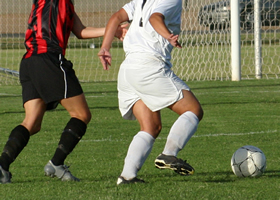Our Services
Achilles Tendon Repair (Acute & Chronic Tears)
 An Achilles tendon rupture is a common injury that involves a tearing of the thick band of tissue that connects the calf muscle to the heel and helps with nearly any kind of foot movement. The Achilles tendon can be partially or completely torn and most commonly occurs as a result of repeated stress on the tendon.
An Achilles tendon rupture is a common injury that involves a tearing of the thick band of tissue that connects the calf muscle to the heel and helps with nearly any kind of foot movement. The Achilles tendon can be partially or completely torn and most commonly occurs as a result of repeated stress on the tendon.
Most Achilles tendon injuries require surgery to reattach the tendon and allow the patient to resume normal foot function. Nonsurgical treatment is only reserved for the mildest of cases or for patients who lead a sedentary lifestyle. Until surgery is performed, patients will likely suffer from recurring (chronic) tears.
During the Achilles tendon repair procedure, an incision is made along the back of the ankle to access the tendon. The torn ends are then reattached using strong sutures that are placed on both ends. The sutures are tied together and the incision is then closed.
After surgery, patients will need to undergo six to eight weeks of physical therapy while the foot heals in a walking boot or cast. The foot may be positioned differently within the cast as healing progresses to maximize movement.
Ankle Pain/Sprain
A sprain is a stretching or tearing of one or more ligaments, the tough fibrous bands that hold the ankle bones in place. Sprains can be caused by a sports injury, accident or stepping on an uneven surface. Symptoms may include pain, swelling, stiffness and bruising. There may be a popping sound when the ankle is moved. The ankle may be unstable or unable to hold weight.
Sprained ankles should be examined by a doctor to rule out the possibility of a bone fracture or other damage. Professional care will also ensure that the joint heals properly, limiting the chance of further injury.
Arthritis
Nearly one in three adults suffers from the swollen, stiff and painful joints of arthritis. The most common type is osteoarthritis, a degenerative joint disease in which the cartilage protecting the bone ends wears away.
Treatment typically involves a combination of anti-inflammatory medication and devices to relieve stress on the joint (canes, crutches or splints). Regular exercise, weight loss for overweight patients and cortisone injections may also be helpful. In severe cases, orthopedic surgery such as joint replacement may be the only way to restore function and relieve pain.
Athlete's Foot Treatment

Fungal infections may be mild or severe, last a short or a long time, clear on their own or require professional treatment. They may recur over time. They may also develop into more significant problems such as bacterial infection, especially if a person scratches at the infected areas. People with diabetes should be especially attentive.
Blisters
A blister, or bulla, is a bubble of fluid that normally forms beneath a thin layer of damaged skin. The fluid inside it is composed of water and protein that have oozed from the damaged tissue. Blisters typically form as a result of a rubbing irritation that may be caused by ill-fitting or new shoes. They generally involve only the top layer of the skin, or epidermis. Such blisters usually resolve in a short period of time on their own and do not result in complications or scarring.
If the blister has formed on a portion of the foot that requires pressure to be placed on it, such as the sole, it may help to apply a moleskin pad with an open center to protect the blister. In those cases in which a shoe produced the irritation, it is important to avoid wearing that particular pair or any others that will similarly rub the blister until after it has broken.
Blisters can easily become infected. Patients who have a blister that is not healing, causing increased pain, becoming red or swollen, oozing pus, developing red streaks or feeling warm to the touch should have it evaluated by a doctor immediately.
Bunions
A bunion is a common condition that involves an abnormal, bony bump at the base of the big toe, causing the joint to swell outward and become painful. The big toe may also turn inward toward the second toe as a result of the enlarged joint, which can then lead to difficulty walking, ingrown toenails and corns and calluses.
Bunion treatment depends on the severity of the condition, although early treatment is considered most effective. Mild bunions may be relieved of pain simply by changing shoes, applying ice or taping your foot into a normal position. Medication, orthotics and physical therapy may also be recommended by your doctor. Surgical treatment, usually reserved for more severe cases, can improve pain, inflammation and deformities.
Corns & Calluses
Corns and calluses are thickened layers of skin that develop on the feet as a result of the skin protecting itself from friction and pressure. Corns and calluses do not often cause serious medical problems, but they may be painful, especially when walking. Many patients are also bothered by their appearance.
Patients should see their doctor after detecting a corn or callous to determine whether or not it needs to be removed. Patients with diabetes may be at a higher risk of developing complications from these conditions and should seek immediate treatment. Treatment for corns and calluses may include:
- Trimming the excess skin
- Salicylic acid
- Antibiotics
- Shoe inserts
- Surgery
Cysts
A cyst is a fluid-filled lump that forms in the deeper layers of skin when a hair follicle becomes blocked. They can be uncomfortable and unsightly but are harmless (benign). Nevertheless, any suspicious growth on the skin should be examined by a dermatologist to determine whether it is cancerous. If infected, a cyst may require treatment with antibiotics. Patients with large or painful cysts may choose to undergo minor surgery. Cysts can occur anywhere on the body but commonly appear on the face and scalp, trunk and fingernails. They include acne whiteheads and comedones, milia, and dermoid, epidermal, trichilemmal and pilar cysts.
